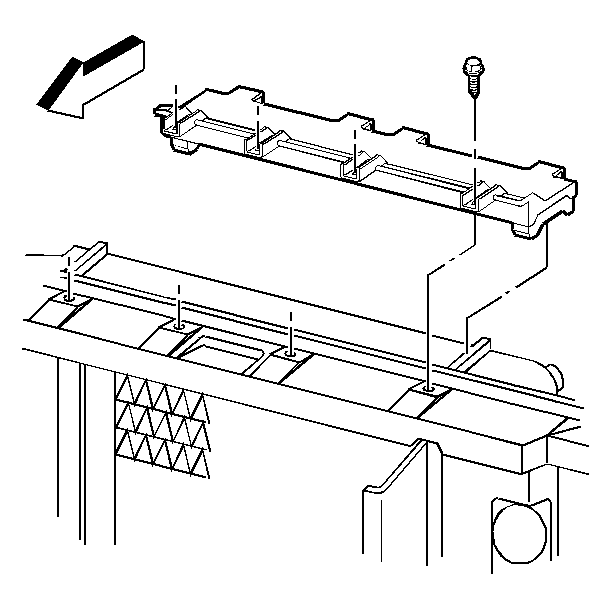Removal Procedure
- Disconnect the negative battery cable. Refer to
Caution: Unless directed otherwise, the ignition and start switch must be in the OFF or LOCK position, and all electrical loads must be OFF before servicing any electrical component. Disconnect the negative battery cable to prevent an electrical spark should a tool or equipment come in contact with an exposed electrical terminal. Failure to follow these precautions may result in personal injury and/or damage to the vehicle or its components.
in General Information. - Remove the air intake duct and the air cleaner resonator.
- Drain the coolant from the cooling system. Refer to Cooling System Draining and Filling .
- Disconnect the engine coolant hoses from the radiator. Refer to Radiator Hose Replacement .
- Remove the engine cooling fans.
- Disconnect the transmission oil cooler lower and upper pipes from the radiator. Plug the transmission oil cooler lower and upper pipes.
- If equipped, remove the engine oil cooler inlet and outlet hoses from the radiator.
- If the vehicle is not equipped with a mechanical fan, remove the bolts and the radiator upper mounting panel.
- Remove the radiator.
Notice: When adding coolant, it is important that you use GM Goodwrench DEX-COOL™ coolant. If coolant other than DEX-COOL™ is added to the system, the engine coolant will require change sooner: at 50 000 km (30,000 miles) or 24 months.
| • | Engines with RPO VO8 heavy-duty cooling system, refer to Electric Cooling Fan . |
| • | Engines with base cooling system, refer to Electric Cooling Fan . |

Installation Procedure
- Install the radiator. Make sure that the radiator sits on the radiator insulators.
- Install the radiator upper mounting panel and the bolts, if removed.
- Connect the coolant recovery reservoir hose to the radiator.
- Connect the transmission oil cooler lower and upper pipes to the radiator. Refer to Transmission Oil Cooler Flushing Procedure in Transmission.
- Connect the engine oil cooler inlet and outlet hoses to the radiator, if equipped.
- Install the engine cooling fans.
- Connect the engine coolant hoses to the radiator. Refer to Radiator Hose Replacement .
- Connect the negative battery cable.
- Refill the engine coolant. Refer to Cooling System Draining and Filling .
- Start the engine. After the engine reaches normal operating temperature, check for coolant leaks.

Tighten
Tighten the bolts to 6 N·m (53 lb in).
Notice: Use the correct fastener in the correct location. Replacement fasteners must be the correct part number for that application. Fasteners requiring replacement or fasteners requiring the use of thread locking compound or sealant are identified in the service procedure. Do not use paints, lubricants, or corrosion inhibitors on fasteners or fastener joint surfaces unless specified. These coatings affect fastener torque and joint clamping force and may damage the fastener. Use the correct tightening sequence and specifications when installing fasteners in order to avoid damage to parts and systems.
Tighten
Tighten the transmission oil cooler lower and upper pipes to 23 N·m
(17 lb ft).
Tighten
Tighten the engine oil cooler inlet and outlet hoses to 24 N·m
(18 lb ft).
| • | Engines with RPO VO8 heavy-duty cooling system, refer to Electric Cooling Fan . |
| • | Engines with base cooling system, refer to Electric Cooling Fan . |
Tighten
Tighten the negative battery cable bolt to 17 N·m (13 lb ft).
